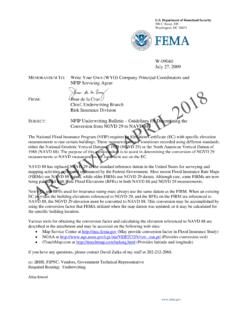Transcription of National Flood Insurance Program (NFIP) Direct Servicing ...
1 Department of Homeland Security 500 C Street, SW Washington, DC 20472 W-13025a May 14, 2013 MEMORANDUM FOR: Write Your Own (WYO) Principal Coordinators and the National Flood Insurance Program (NFIP) Direct Servicing Agent FROM: James A. Sadler, CPCU, AIC Director of Claims Federal Insurance and Mitigation Agency SUBJECT: Claims Guidance - Structural Drying and Other Related Items The purpose of this bulletin is to provide claims guidance regarding coverage for structural drying under the Standard Flood Insurance Policy (SFIP).
2 This paper assumes some knowledge on the part of the reader, but reference to the glossary and other addenda can be helpful. The SFIP pays the cost to repair damage that is a Direct physical loss by or from Flood , as Flood is defined in the SFIP, to the policyholder s insured property. To the extent that structural drying of the policyholder s insured building meets this test, the claim for building drying may be paid. The SFIP will not pay for claims to dry building components that are typically removed due to the poor quality of the Flood water removal of carpet and drywall appropriate to the flooding is a typical example.
3 Building materials are typically porous, and when in contact with Flood water the more porous materials may not be salvageable. Building materials that are salvageable are less porous so less water is absorbed; however, because of this characteristic, the absorbed moisture does not pass through the material easily, making salvageable building materials generally difficult to dry. Water on the surface of material with low porosity quickly evaporates; however, because air movement cannot reach inside the material, a different approach to the removal of the absorbed water held inside material (bound water) is more effective than previous approaches.
4 This method (drying bound water after removing unsalvageable building materials) emphasizes a specific type of dehumidification equipment, a changing approach to the utilization of air movement, and an increased role of temperature. Evaporating water within salvageable building material can be best accomplished by increasing the vapor pressure differential, which is the force created between the moisture in the affected material compared to the amount of water vapor removed in the affected air. When the outdoor environment or the building s HVAC system is insufficient for drying, the most effective means to increase vapor pressure differential is with low grain refrigerant (LGR) or desiccant type dehumidifiers, which are capable of removing a significant amount of moisture from Cl aim Guidan ce Structural Drying andOther R elated ItemsMay 14, 2013 Page 2 the affected air.
5 The drying process can be aided by elevating the temperature of affected material with the introduction of low controlled heat; this will promote the release of moisture bound inside the material so it can be drawn into the affected air and removed by dehumidification. While initially some high velocity air movement from centrifugal fans may be needed to help evaporate surface and free water when it is present, the emphasis for the greater volume of air movement from axial fans is most effective to complete the drying process (see: Figure 1). Before mechanical drying is initiated, non-salvageable building and contents items should be removed, salvageable building material should be cleaned and treated against mold and mildew, and the affected components of the building s main electrical and HVAC systems should be restored and sanitized.
6 Separation of the affected area from unaffected areas should be re- established if required prior to tear-out. Once accomplished, mechanical drying can commence. These costs may be included in Flood Insurance claims estimate by one of the following methods: 1. Square foot (SF) allowance when rented equipment or professional services are not involved, a SF allowance to dry can be considered. Such allowance would represent the usage and costs of operating the HVAC system beyond the typical seasonal use and for fans , dehumidifiers or space heaters the insured may use. Reasonable adjustments should be applied if drying non-living spaces or areas of a building with no climate control.
7 2. When drying services are performed and the submission of an itemized invoice is not supported with a properly completed drying log, consideration for the duration, type, and number of equipment should follow these guidelines once a reasonable attempt to verify the quantity and type of equipment is made: Duration drying should be performed for 1, 2, or 3 days based on the degree of saturation at the onset of drying. Consider the following factors: The length of time Flood water remained inside the building; The reasonable period unsalvageable materials remained installed; and The length of time after the removal of unsalvageable building items, building clean-up and sanitizing was performed, to the start of mechanical drying.
8 Dehumidifiers capacity is based on the quantity of material saturated by bound water: In climate-controlled areas, the following formulas should be used with the respective dehumidifier type in order to determine the amount of dehumidification capacity necessary: o Low Grain Refrigerant (LGR) unit: volume of the affected area in cubic feet 50 = the required AHAM pints. o Desiccant unit: volume of the affected area in cubic feet 60 x 2 = required CFM. o When both type of dehumidifiers are utilized in the same affected area, the combined capacity of all the units should not exceed the capacity determined of one formula.
9 O Standard or conventional refrigerant units should not be considered. Cl aim Guidan ce Structural Drying andOther R elated ItemsMay 14, 2013 Page 3 For interior building areas with minimal saturated material or with limited climate control, , an unfinished basement or cellar, dehumidification capacity should be reduced. For areas of a building exposed to soil or outdoor conditions, , crawlspaces, attached garages, or attached utility and storage rooms, dehumidification should not be considered. Ducting (flex or plastic lay-flat) may be utilized with desiccant units.
10 Air movers (see Figure 2 and 3): The number of air movers on day one (one day duration) should be based on the following: o Elapsed time between the completion of building tear-out, cleaning and sanitizing, to the start of mechanical drying; o Presence of affected salvageable material: Exposed perimeter wall sheathing one air mover per 16 LF Salvageable floors at least one air mover per room or closet; o With interior wall removal: The elimination of the one air mover per room or closet criteria Requires a greater emphasis on the volume of air movement o Total size of the affected area.





